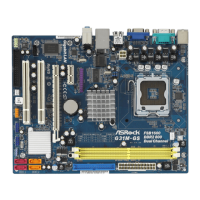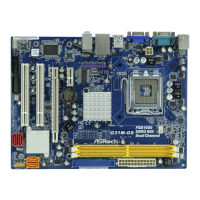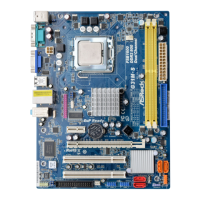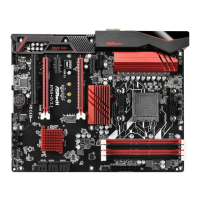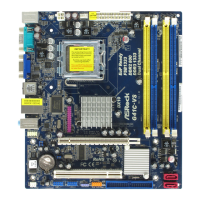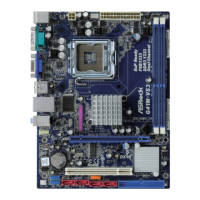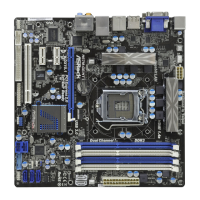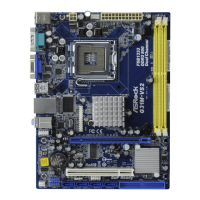
Do you have a question about the ASROCK G31M-VS2 and is the answer not in the manual?
| Non-ECC | Yes |
|---|---|
| Number of memory slots | 2 |
| Maximum internal memory | 8 GB |
| Processor socket | LGA 775 (Socket T) |
| Processor manufacturer | Intel |
| Number of SATA connectors | 4 |
| Number of Parallel ATA connectors | 1 |
| USB 2.0 ports quantity | USB 2.0 ports have a data transmission speed of 480 Mbps, and are backwards compatible with USB 1.1 ports. You can connect all kinds of peripheral devices to them. |
| Firewire (IEEE 1394) ports | 0 |
| Audio chip | VIA VT1705 |
| Certification | FCC, CE |
| Power source type | ATX |
| Audio output channels | 5.1 channels |
| Motherboard form factor | micro ATX |
| Compatible operating systems | Win XP, Vista, 7 |
| Networking features | 10/100 Mbps |
| BIOS memory size | 32 Mbit |
| Depth | 170 mm |
|---|---|
| Width | 226 mm |
Lists the items included with the ASRock G31M-VS2 motherboard package.
Details the motherboard's form factor and general platform specifications.
Lists CPU socket type, supported processors, FSB, and technologies.
Identifies the Northbridge and Southbridge chipsets used on the motherboard.
Specifies memory type, number of slots, and maximum capacity.
Details the types and number of expansion slots available.
Describes the onboard graphics processor and its capabilities.
Specifies the onboard audio codec and channel support.
Details the onboard LAN controller and speed.
Lists all connectors and ports available on the rear panel.
Lists onboard headers and connectors for internal devices.
Lists key BIOS features and capabilities.
Details the contents of the support CD.
Highlights special or unique features of the motherboard.
Lists hardware monitoring parameters like temperature and fan speed.
Lists compatible operating systems.
Lists compliance certifications for the motherboard.
Identifies ATX 12V and main ATX power connectors.
Shows the location of the memory slots.
Locates IDE and SATA connectors for storage devices.
Identifies headers for system controls and front panel audio.
Shows the location of PCI and PCI Express slots.
Locates the USB 2.0 headers on the motherboard.
Identifies the BIOS chip and Clear CMOS jumper.
Locates PS/2, USB power, and parallel port headers.
Identifies rear panel ports like PS/2, USB, RJ-45, VGA, and COM.
Explains the LED indicators for the LAN port status.
Instructions for enabling multi-streaming audio.
Instructions on using screw holes to secure the motherboard.
Essential safety and handling precautions before component installation.
Overview of the CPU socket and its components.
Detailed steps for opening the CPU socket lever and plate.
Instructions for orienting and holding the CPU for insertion.
Guidance on vertically placing the CPU and confirming seating.
Instructions for removing the CPU socket's protection cap.
Steps to close the CPU socket lever and plate after installation.
Instructions for applying thermal paste to the CPU IHS.
Guide on positioning the heatsink and securing it.
Instructions for connecting the CPU fan cable and managing it.
How to open the retaining clips on a DIMM slot.
Guidance on aligning the DIMM's notch and inserting it correctly.
Description of the standard PCI slot.
Description of the PCI Express x16 slot.
Steps for installing an expansion card into a slot.
Configuration for PS/2 and USB wake-up events.
How to clear CMOS settings using the jumper.
Details the 39-pin IDE connector and cable connection.
Shows the four SATAII connectors and their speed.
Describes the SATA data cable connection.
Locates the USB 2.0 headers on the motherboard.
Identifies the 25-pin header for printer devices.
Explains the 4-pin connector for audio input.
Instructions for connecting front panel audio.
Identifies the header for system control buttons and LEDs.
Locates headers for chassis speaker and fan connections.
Explains connection for 24-pin and 20-pin ATX power supplies.
Instructions for setting jumpers on Western Digital hard disks.
Instructions for setting jumpers on SAMSUNG hard disks.
Information on using Hitachi's tool for ATA features.
Overview of the BIOS setup utility and how to enter it.
Description of the BIOS menu bar selections.
Explains the function of navigation keys within the BIOS.
Displays the system overview on the BIOS Main screen.
Settings related to CPU performance and features.
Ratio status, actual value, and CMOS setting for CPU ratio.
Enables/disables Boot Failure Guard and Spread Spectrum.
Configures Intel Virtualization, Thermal Throttling, NX, Hyper-Threading.
Settings for motherboard chipsets and memory configuration.
Adjusts memory access timings (CL, RCD, RP, RAS).
Configures primary graphics adapter and DVMT settings.
Enables or disables the onboard HD Audio feature.
Controls front panel audio and onboard LAN features.
Allows selection of DRAM, NB, VTT, and +1.5V voltages.
Manages Intelligent Energy Saver and DRAM RCOMP settings.
Configures Suspend-to-RAM and power state after AC loss.
Enables/disables system wake-up via Ring-In, PCI, PS/2, RTC.
Enables or disables the ACPI HPET Table.
Configures ATA/IDE devices for legacy or native OS.
Sets IDE device TYPE, LBA/Large Mode, PIO, and DMA modes.
Configures Block Transfer, S.M.A.R.T., and 32-Bit Data Transfer.
Sets PCI device latency timer.
Enables or disables the PCI IDE BusMaster feature.
Sets the address for the onboard serial port.
Sets parallel port address, mode, EPP version, and IRQ.
Sets the ECP mode DMA channel.
Enables or disables the onboard USB controllers.
Enables or disables USB 2.0 support.
Selects legacy support options for USB devices.
Manages CPU fan speed based on temperature.
Sets the target temperature for the CPU fan control.
Adjusts the target fan speed level.
Configures boot order and priority.
Enables/disables Full Screen Logo and AddOn ROM Display.
Enables/disables booting from onboard LAN and sets Num-Lock.
Saves current settings and exits the BIOS setup.
Exits BIOS setup without saving changes.
Allows saving and loading user-defined BIOS settings.
Guide to installing supported operating systems.
Details the contents and usage of the support CD.
Explains drivers and utilities available on the support CD.
Provides contact information and website for ASRock.


